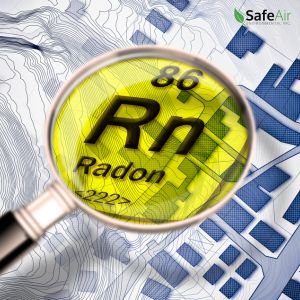How Radon Exposure Can Affect Pregnancy
Posted in Radon Testing, on July 21, 2025
When you’re expecting a new addition to your family, hidden air quality issues are often the last concern on your mind. At SafeAir, we suggest home air quality testing any time there is a significant life change at home, whether it be a new baby, an elder moving in, a renovation, or a new house. Safe and science-based air quality testing will help you understand the potential pollutants or harmful conditions that can have subtle but serious impacts on your health. One of the common concerns we hear from clients is about radon exposure and pregnancy. Radon detection is a safe and straightforward service, but many folks don’t understand where, when, or why it’s best to have your home tested. Here’s what you need to know!
Why Radon is Especially Concerning for Pregnant Women
 Radon is a radioactive gas that has no smell and no visible or audible effects. That makes it impossible to detect without specialized tools and testing, but also easy to ignore or put off for another day — out of sight and out of mind. Parents expecting new children should consider the unknown risks of prenatal exposure to radon during pregnancy, however. Radon gas affects humans through our respiratory system; when breathed in, the gas causes minute damage to tissues and cells. Over time, this damage leads to lung cancer.
Radon is a radioactive gas that has no smell and no visible or audible effects. That makes it impossible to detect without specialized tools and testing, but also easy to ignore or put off for another day — out of sight and out of mind. Parents expecting new children should consider the unknown risks of prenatal exposure to radon during pregnancy, however. Radon gas affects humans through our respiratory system; when breathed in, the gas causes minute damage to tissues and cells. Over time, this damage leads to lung cancer.
Because it’s invisible, the long-term effects of prenatal exposure to radon gas are hard to quantify. Developmental issues and respiratory conditions are two areas where science is taking a hard look — in one study, associations with cleft palate and cystic hygroma were found in areas with high radon levels, but further research was needed to give a definite answer. Other studies suggest that radon exposure may play a role in gestational diabetes, hypertension, and miscarriage.
How Radon Enters the Home
Radon is created deep in the earth’s crust from decaying uranium. It is naturally emitted from soil and rock and is generally harmless when you’re outdoors. Indoors, however, is another story. Science has found that homes, especially those with sub-level basements, often pull in radon gas from the surrounding earth, which increases the concentration to toxic levels. The radon gets in through cracks in the foundation, windows, doors, and sump pumps, and can linger because of poor ventilation and airflow.
Heath Impacts of Long-Term Exposure
Professional radon detection is the only way to know if radon gas is collecting in your home. While the short-term effects are hard to quantify, there’s no doubt that long-term exposure has life-threatening consequences. After tobacco smoke, radon is the leading cause of lung cancer across Canada and much of the United States.
The radon health risks are well known and will affect every member of a household. Because safe indoor air quality is linked to so many different health outcomes, from your sleep to your lung to your brain, air quality testing is critical to understanding the hidden but imperative role that your indoor environment plays.
Prevention Through Testing and Mitigation
Preventing radon exposure starts with home air quality testing. Radon testing can help you understand your risk and provide peace of mind. At SafeAir, we use an industry-standard device and testing protocol that delivers trustworthy, science-led results, which we’ll help you interpret so that you can choose the mitigation system that suits your needs. When you need radon testing for homes, the SafeAir team is ready to help ensure a healthy environment for you and your baby — contact SafeAir for professional radon testing today.

